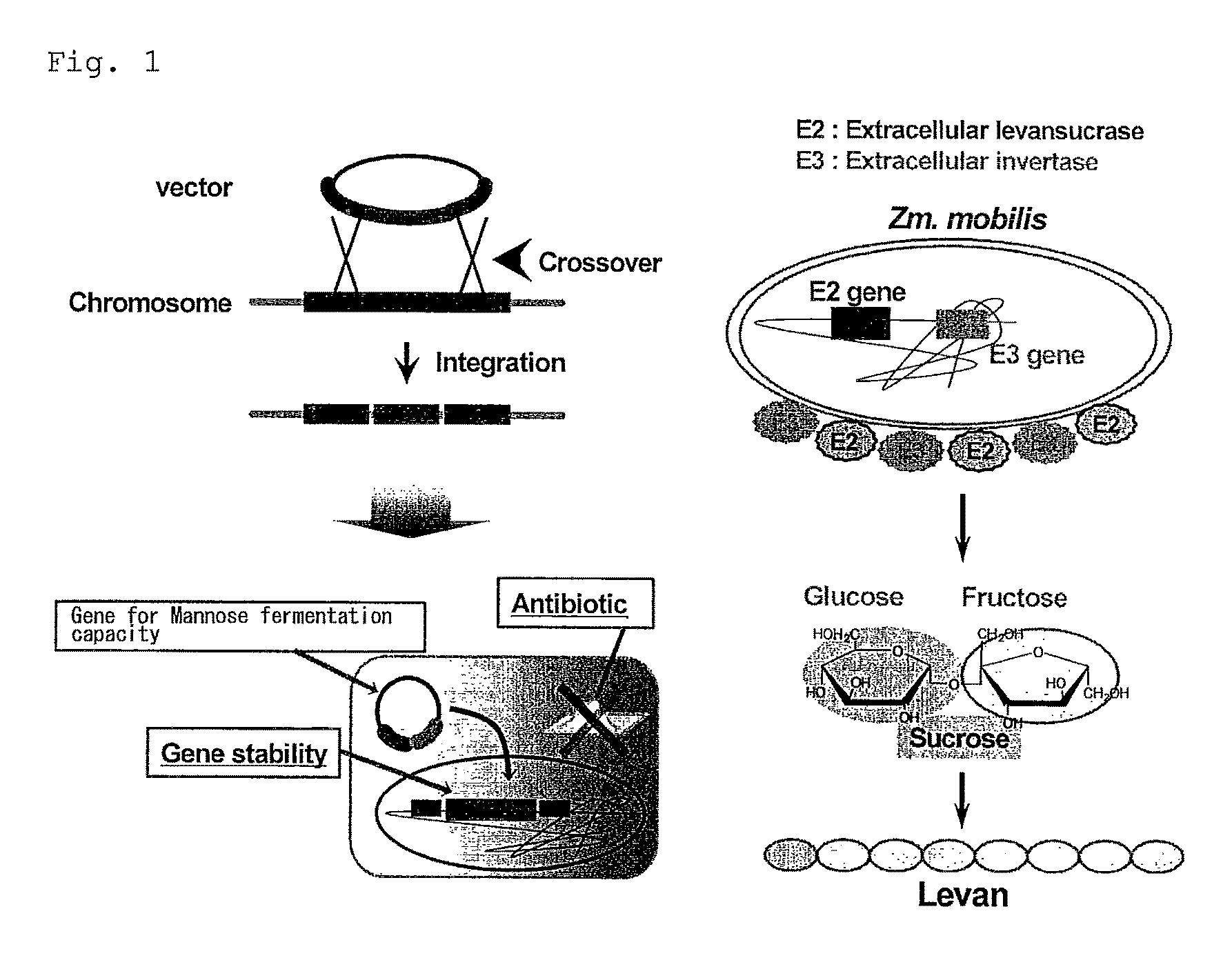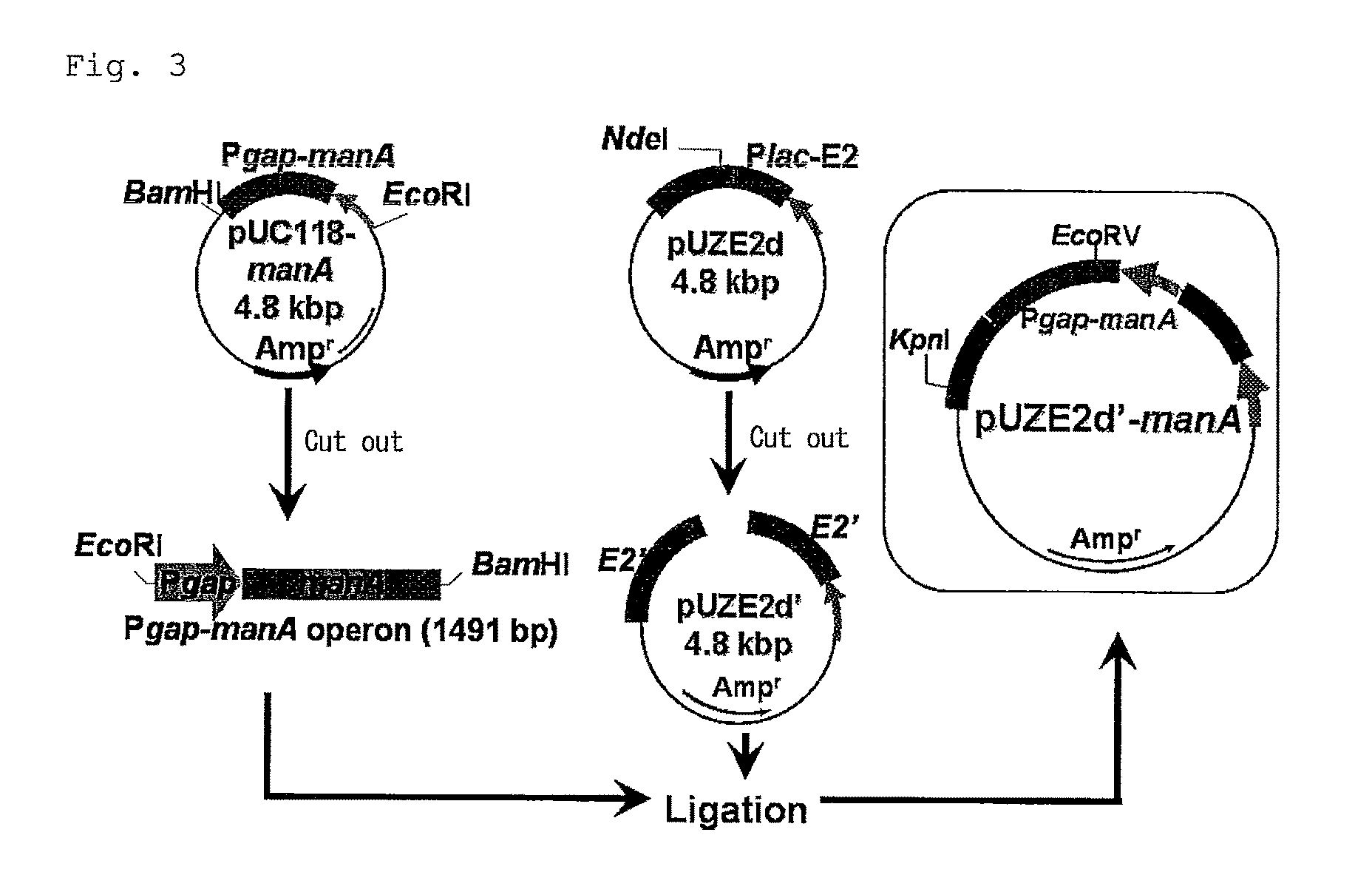Bacterium capable of fermenting glucose, mannose and xylose simultaneously, and method for production of bioethanol using the bacterium
a technology of xylose and mannose, which is applied in the field of fermentative bacteria, can solve the problems of no fermentative bacteria available in nature, and achieve the effects of strong glucose fermentation capacity, no fermentation, and mannose fermentation capacity
- Summary
- Abstract
- Description
- Claims
- Application Information
AI Technical Summary
Benefits of technology
Problems solved by technology
Method used
Image
Examples
example 1
Integration of Phosphomannose Isomerase Gene (manA)
[0066](1) Cloning of Phosphomannose Isomerase Gene (manA) of Escherichia coli (E. coli) Origin
[0067]A DNA fragment containing a target gene was amplified by PCR using a combination of the synthetic oligonucleotides shown in Table 1 which were designed based on a known glyceraldehyde-3-phosphate dehydrogenase gene sequence of Zymomonas mobilis (Zm. mobilis) origin (J. Bacteriol. Vol. 169 (12), 5653-5662, 1987) and a known manA nucleotide sequence of E. coli origin (Gene 32 (1-2), 41-48 (1984)).
[0068]First, primary PCR was carried out using the chromosomal DNA (Chr. DNA) of a wild strain of Zm. mobilis (IFO13756) as a template to amplify the gap promoter. Similarly, manA was amplified using the Chr. DNA of E. coli K12 strain as a template. Then, the two PCR products were used to form a hetero-double strand. Secondary PCR was carried out to construct a gap-manA fragment, and this fragment was ligated to the HincII site of vector pUC118...
example 2
Giving Simultaneous Fermentation Capacity of Xylose to Bacterial Strain
[0079]In order to introduce genes of enzymes in xylose metabolism system of E coli origin into Zm. mobilis, first, genes of xylA, xylB, tal and tktA were cloned in E. coli using vector pUC118, and then inserted into a shuttle vector for E. coli and Zm. mobilis, pZA22, to construct a recombinant plasmid pZA22-xt. Then, pZA22-xt was introduced into Zm. mobilis to which mannose fermentation capacity had been given by integrating manA into the chromosome thereof. Thus, the simultaneous fermentation capacity of glucose, xylose and mannose was given to the strain.
[0080](1) Construction of pUC118-xylAB
[0081]The necessary genes were cloned from E. coli genomic DNA by PCR. Further, a promoter gene (GAP promoter) for controlling the expression of glyceraldehyde-3-phosphate dehydrogenase, which was reported to be expressed in a large amount in Zm. mobilis cells, was used to express the introduced four kinds of enzyme genes ...
example 3
Giving Simultaneous Fermentation Capacity of Glucose, Mannose and Xylose to Bacterial Strain
[0104]Simultaneous fermentation capacity of mannose and glucose had been successfully given to Zm. mobilis by integrating manA into the chromosomal DNA thereof. Then, a further study was made to give xylose simultaneous fermentation capacity.
[0105](1) Construction of Strain Having Both Genes of Xylose Metabolism System and Mannose Metabolism System of E. coli Origin Together
[0106]Competent cells of ZM ms[E2:manA] having manA integrated into the chromosome obtained in Example 1 were prepared, and the cells were transformed with pZA22-xt (FIG. 10). A transformed strain was selected based on the colony formation on a xylose plate medium. Then, growth of obtained colonies in a liquid medium containing xylose and mannose as carbon sources was monitored. A transformed strain which exhibited high growth in both carbon sources of xylose and mannose was selected and used for a fermentation test.
[0107]...
PUM
| Property | Measurement | Unit |
|---|---|---|
| pH | aaaaa | aaaaa |
| time | aaaaa | aaaaa |
| temperature | aaaaa | aaaaa |
Abstract
Description
Claims
Application Information
 Login to View More
Login to View More - R&D
- Intellectual Property
- Life Sciences
- Materials
- Tech Scout
- Unparalleled Data Quality
- Higher Quality Content
- 60% Fewer Hallucinations
Browse by: Latest US Patents, China's latest patents, Technical Efficacy Thesaurus, Application Domain, Technology Topic, Popular Technical Reports.
© 2025 PatSnap. All rights reserved.Legal|Privacy policy|Modern Slavery Act Transparency Statement|Sitemap|About US| Contact US: help@patsnap.com



